Do you know how to measure your marketing efforts to see what is working vs what is not?
You’ve heard it before. You need to measure what you want to grow. Whether you are just starting out or have been in the game for years, there is always room for improvement.
The following blog post will guide you through performing an assessment that will help you identify the metrics that relate most closely with your goals—and give some suggestions on how to improve them! The key is understanding which metrics matter most to your goals so that you can focus on those aspects of the process.
You don’t have to measure everything — only those essential things that relate to your goals. We’ll guide you through looking at essential metrics to make sure your efforts are paying off… and to make informed decisions about what to do next.
This assessment/check-up can be done any time. I highly recommend doing it mid-year so you can course-correct as needed for the rest of the year.

Download our Free Marketing Metrics Worksheets
Use these to record, analyze and visualize your data to get a clear view of what is happening in your marketing.
⚠️ WARNING: DO NOT ATTEMPT THIS MARKETING REVIEW IN ONE SITTING.????
We recommend grabbing some popcorn, a drink ????????, a big ol’ notebook, and to take your time. You can come back to it and do a little at a time.
Alrighty, put on your big kid marketing pants, and let’s do this!
What should I measure? How do I know if it’s working?

When it comes to digital marketing, there are often tons of activity, many moving parts, and no shortage of things to measure. You may be spending money getting traffic, but is it converting to leads? To sales? Which activity is driving that and which isn’t? You may be creating tons of content, but is it getting traffic and engagement? Which posts are converting better leads?
It’s hard to know where to begin and can be quite daunting. That’s why I’ve written this post — to help you get some clarity from all your activity so you can glean valuable insights that will influence what you do next.
Monitoring and measuring things is fairly straightforward, but gaining actionable insights is a challenge. In our experience, starting with your goals and determining what your KPIs are (key performance indicators) will inform what metrics you should focus on.
In most cases, goals will boil down to some combination and variety of these:
Be seen as an authority (stand out)
- Measure reach, engagement, reviews, opportunities to speak or guest, other people linking to your content, etc.
- Review your branding and messaging, testimonials, as seen on, etc.
Get more leads and opportunities
- Measure traffic, leads, conversion rates, etc.
- Review SEO, lead magnets and user experience, etc.
Get more customers and make more money
- Measure total sales, sales by channel, which products are selling/profiting, conversion rates, etc.
- Review your offers, calls-to-action, website performance, testimonials and other trust signals, user experience, sales processes, referral stimulation, repeat sales, etc.
While some metrics are quantitative such as traffic, leads, sales and revenue, others are less tangible like trust and authority. How will you measure those?
It might be in the form of engagement on social media, invitations to speak (virtual or in person), increase in number of Google reviews (and average rating), etc. Maybe it is your book ranking on Amazon or increasing your “As Seen On” credentials. Sometimes it is simply a subjective review.

The very most important thing here is that you look at relevant and essential things, and try to gain actionable insights. We’re not here for the math! ????
Start with the end in mind
Reference the goals you set for yourself at the start of the year, and keep those in mind as you work through this. If you didn’t really set any, that’s okay. Use this guide to assess where you are and to help you set goals and formulate plans for the following quarters. I like to plan 90 days at a time but also think about what my focus might be for the following 90 days. I don’t get very detailed about the second 90 days yet because, inevitably, things change.

The quality of your outcome depends on the quality of your questions. Through asking the right questions, we can spark innovation and creativity, gain deeper knowledge in the topics that are most important to us, and propel ourselves forward in our personal and professional pursuits.
Warren Berger, on The Knowledge Project Podcast, Ep 26

As you go through the assessment, I expect you will start having a flood of ideas — WRITE THEM DOWN AS THEY COME TO YOU. Trust me, You will forget :). Be specific in your notes. You will forget what you meant. I have lost more ideas than I will ever have again. ????
Is it accurate, important or useful?
“Just because it can be easily measured doesn’t mean that it’s accurate, important or useful.”
Source unknown
There are many dashboard tools out there that pull together common marketing metrics. The problem is, however, are they the right metrics? I have found that they almost never tell me what I need to know. The purpose of all of this is to gain actionable insights and I personally find that when I pull the data together from the individual sources — email marketing/marketing automation tools, Google Analytics, Facebook Ad Manager, Google Ads, social media platforms and scheduling tools, etc. it forces me to think about it as I interact with it.
It is certainly possible to build a dashboard that pulls this all together from your various sources. At Content Creators Planner, we use a customized version of our Free Marketing Metrics Worksheets that you can download and use today and ongoing. In addition, we also use a custom Google Sheet to track revenue and costs per channel so we can monitor profitability each month.
Storytelling and Spreadsheets
“The two skills of modern business: Storytelling and spreadsheets. Know the numbers. Craft the narrative.”
James Clear
Let’s dive in and begin with some of the more qualitative “Storytelling” things first. We will get into the numbers and spreadsheets further below.

The idea here is to simply look at your current practices and materials and make notes about any areas that could use improvement and plan (meaning actually schedule it on your calendar) to work on them over the next 90 days.
Branding & Messaging
Is your brand working for or against you? What does your branding say about you? Strong branding enables you to have premium pricing, greater loyalty, greater share of customers’ wallets, and lower customer acquisition costs to name a few.
It’s important to make the best first, second, third…eleventh impression you can — from your business card to your website, to how you answer the phone and the tone of your emails… your branding communicates what you’re about and who you serve.
Consistency
Is your visual branding and messaging consistent? Across all channels — this means everything — website, business cards, ads, print materials, presentations, thank you pages, email campaigns and automations, etc. EVERYTHING.
Every touch point is an opportunity to make an impression and they all matter. Even how you and your staff answer the phone and return (or don’t) return calls (and emails). Does everything have the same look, voice and feel? Does it feel like it all belongs to the same company?
Professional Look and Feel
Not everyone has the luxury of working with a professional designer and that is okay. However, it is important that your visuals, your logo, your website, your social media images, presentation slides, etc. look current and professional. Be objective here — do they match the level you wish to be seen as? Do they look dated? (it happens)… Good design is about more than aesthetics, it informs and influences. Build value and increase the credibility of your brand by paying attention to this.
Messaging
Is your messaging still relevant and accurate? These things do evolve over time so look at things to see if something is missing or updates are needed:
- Elevator pitch
- One-liner/value proposition
- Your about page story (Is it more about them than you? It should be.)
- Your printed materials
- Your website copy and calls to action
Target Audience/Ideal Prospects (Avatars), Segmenting
Defining the audience to whom you’re marketing makes everything easier, sharper, more relevant and targeted. If you know and understand to whom you are speaking, your message and your services will be more likely to reach them, touch them, and connect with them which translates to traffic, leads and sales to you and they will develop a stronger affinity for your brand.
Avatars evolve as we learn more about them, or their needs change. Sometimes we need to add new ones. Review your targeting:
- Is it documented someplace? Is your team aware?
- Have you learned anything new about them?
- Have you surveyed your customers lately for new insights or feedback?*
- Do you need to further segment and/or refine?
- Is it time to add a new target audience segment into the marketing mix?
Are you segmenting your email marketing?
- Do you have different landing pages, emails and language for each avatar?
- Is one performing better than another? Do you have any insights as to why?
- Do you have ideas for other target segments to develop?
*If you haven’t done this already, you can survey your customers… and you can gather data about them for things that will help you better reach and serve them like:
- Average age, gender, spending capabilities and habits, profession, and geographical location.
- What platforms they use most to discover and engage with brands, whether that’s a certain social media channel, email, Google search, word of mouth, or something else.
- What are their biggest challenges (that you can help them with)?
Consider this: Watering things down to “reach more people” to appeal to a broader audience does not work. Focus on specific niches, narrower audiences/segments, and address their needs and concerns specifically. You may have more than one target audience and that is fine. Develop content, messaging, and campaigns specific to each. They may be very similar with only slightly different language and images — but those subtle differences may have big impact on results.

Review your current segmenting, messaging and product offers and see if they are still in alignment with your target audience(s). Jot down your thoughts as they come to you.
Customer Journey (your sales funnel)
You should be doing something intentional for every step of your customers’ journey. It can be simple. But if you are overlooking a step, you are missing out.
Do you have good content for each stage of your customer’s journey?
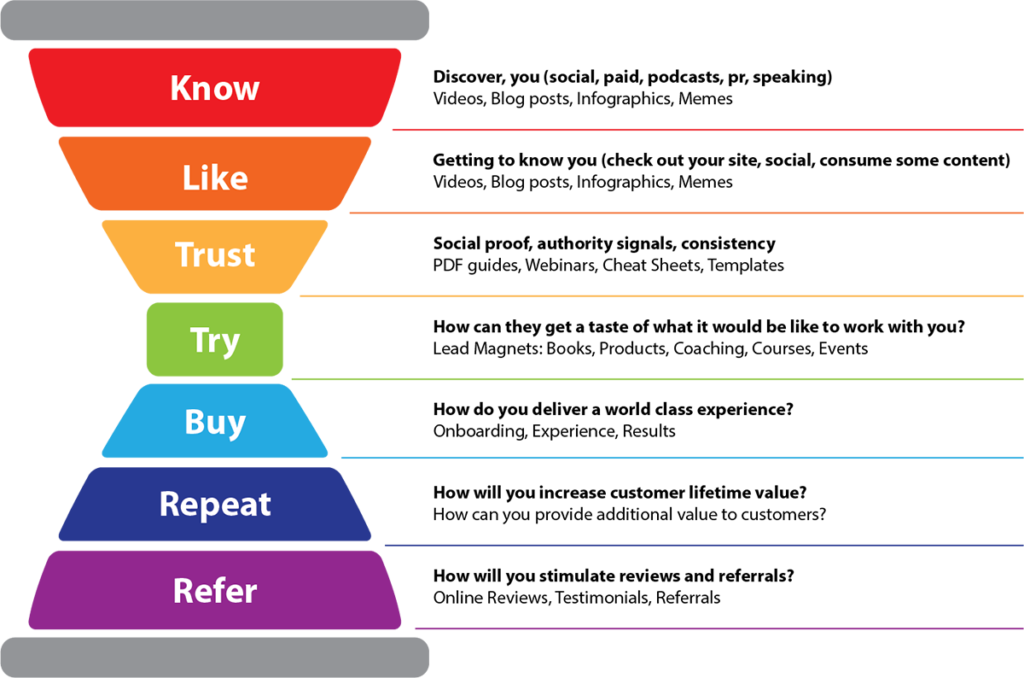
Many people simply focus on tactics without an overall strategy. While you may have some success, I would say you have a leaky bucket, and you would have far greater success if you plugged the holes in the bucket before you pour any more effort into it.

Review what and how you are doing at each stage of the customer journey (your sales funnel). We will get into the numbers down below. For now, just review what you have in place and note your thoughts along the way.
Know
Review your activities at the top of your funnel. Record your thoughts as they come to you.
- Are they working?
- Are you consistent?
- Are you growing your audience and reach?
Like
Review this stage of your funnel and make notes as you go.
- Are you retaining your audience?
- Are you getting good engagement on social media and in email?
Trust
Trust and authority can impact your sales conversion rate (and your lead conversion rate). If your rates have improved, it stands to reason that you are more trusted or have greater authority. But also, maybe you simply improved your sales processes or lead magnets.
Trust and authority are hard to quantify…
- Do you have authority signals (certifications, awards, as seen on, client list/logos, etc.) and social proof (testimonials and reviews) wherever you can?
- Are you doing anything to get more of these?
Increase in referral traffic and backlinks is another sign of increasing authority and trust.
Try
How do prospects get a taste of what you offer? These are things like lead magnets, webinars, complimentary coaching sessions, live workshops, etc.
- Do you have these things in place? How are they working?
- Are you getting new leads? Is your list growing?
- Is your list converting to customers?
- At what point do they convert?
- Have you tried optimizing this by testing variables?
- Are your lead magnets specifically designed to capture leads for specific products?
- Do you have nurture drips in place?
- Are you segmenting and personalizing the drip emails?
- Do these need a refresh?
Download Our Free Marketing Metrics Worksheets
Use these to record, analyze and visualize your data to get a clear view of what is happening in your marketing.
Buy
Review your sales from the last 3-6 months (or a year if you are doing a year-end review).
- How much did you make from each product and/or service?
- Which channels drove more sales (in total but also break it down per product).
- What is your conversion rate and cost per acquisition?
- Review other costs — are you profitable?
- Should you consider product refreshes? New products? Product bundles?
Also consider: is it easy to buy from you? Could it be easier?
Repeat
Look at your current and past customers. It costs far less to sell to existing customers than to acquire new ones.
Are you getting repeat sales from customers? Why do you think that is? What can you do to Improve this?
Consider ways you might stimulate repeat sales:
- Develop new product offers
- Remind them when it is time to replenish
- Offer a VIP incentive
- Offer something special to high value customers (purchased 3x or more, or over a $ threshold)
- How can you re-engage former customers who have not come back in quite awhile?
Refer/Review
Are you consistently getting referrals and reviews? Are you asking for them? Or stimulating them in some way? Do you ask for them as part of your onboarding/offboarding processes?
Are you using these for social proof and testimonials on your website and in other materials like ebooks and elsewhere? Making the ask for referrals and reviews is also a good way to spot case study opportunities.
Work this into your onboarding and offboarding automations to make it easy and consistent. Think about:
- What channels for reviews make the most sense for your business? Facebook? Google? Yelp?
- What is the best time to ask for a referral? (hint: it is usually at whatever point the customer is most excited — right after signing up/purchasing and as the engagement is wrapping up.) The easier you make it for them to do, the more likely they are to actually do it.
Productivity
OK, I have to ask… Are you getting things done consistently? (Remember, consistent imperfect action is our mission.) This is a tough one for a lot of people. Be kind but honest with yourself so you can address whatever the issues are and set yourself up to succeed.
Ask yourself:
- Are you spinning your wheels?
- Procrastinating?
- Are things taking too long?
- Do you have documented processes in place?
- If yes, are they working well? Why/why not?)
- If no, get on that!
- Are you over scheduled/overwhelmed? Are you trying to do too many things?
- Are you spending time on things that do not matter?
- Are you tasking yourself with things that would be better delegated or eliminated?
- Do you have a documented strategy or plan in place so that you know what to execute on? Or is it more freeform? (I know of a great content marketing planner that can help you with that.) ????
Past behavior is the best predictor of future behavior. There are so many ways to play to your strengths. Don’t let bad patterns or gaps in skills be the obstacle. If you aren’t getting this done, be honest as to why… and then take action to change it.
- When it comes to content creation, if you can’t or won’t be consistent, for whatever reason, maybe you should create a few strong cornerstone pieces of content (hire a writer) with good lead magnets and nurture campaigns…. then run paid traffic to these pieces of content.
- Consider guesting on podcasts, or guest posting on authority sites instead of producing your own original content.
It really can be that simple. With a plan like this, (notice I said the “P” word), you can have a marketing machine where you are not producing an endless stream of content.
Let’s stop here for a moment…
Before we jump into the numbers and the math, how are you feeling about things?
Motivated? Defeated? Overwhelmed? Determined?
Don’t be hard on yourself. The world is hard enough… the idea here is to take an honest look at where things are and why… and create a realistic plan to move forward and achieve your goals.
THE METRICS
Monitoring, Measuring and Analyzing the Digital Marketing Data

Let’s now gather the data points and get them into the spreadsheet and see where we are. Pull out your analytic tools and let’s figure out where we are as compared to our goals and fine-tune our efforts to stay on track. The goal here is to monitor and measure so we can determine where we need to focus. Plan for success, and execute on that plan.
Download Our Free Marketing Metrics Worksheets
Use these to record, analyze and visualize your data to get a clear view of what is happening in your marketing.
You will need access to:
- Google Analytics
- Email Marketing/Marketing Automation
- Facebook Ad Manager
- Google Ads
- Any other paid traffic sources you may be using
- Social Media Accounts
If you are new to Google Analytics, here are a couple of great resources from Neil Patel to help you get started.
- How to setup Google Analytics
- How to use Google Analytics
- Bonus: How to setup and use Google Search Console.
Reach
Marketing Reach is a good indicator of how well the content you are publishing is engaging your network, and how effectively you are growing your entire marketing database. If this number isn’t growing, it will be challenging to grow your number of leads.
Total Reach
Total reach is the total number of people you can reach across all your channels/networks combined. Think of this as your total potential prospects count. Ideally, your reach should be increasing month over month.
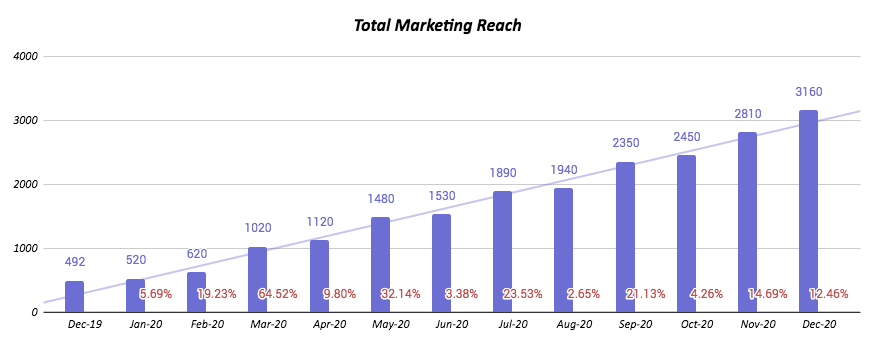
Reach by Channel
Reach by channel tells you how many people follow or subscribe on each channel. Ideally, each should be increasing month over month.
- Is your reach growing month over month?
- Do you see any opportunities for improvement?
- Is there anything you might want to abandon?
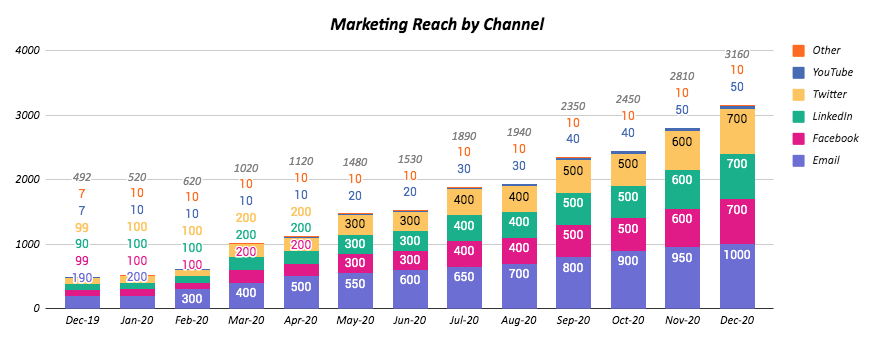
Traffic
The number of website visits details how many people came to your website in a given time period. Tracking this activity is key to understanding how well your marketing is succeeding at attracting and directing people to your website.
- Are you producing quality content and promoting it and optimizing it for organic traffic?
- Are you running paid traffic?
- How are these campaigns working? Are they profitable?
Total Website Visits
How many people are visiting your website? Is this number growing month over month? As your reach grows and you publish more content, this number should be increasing.
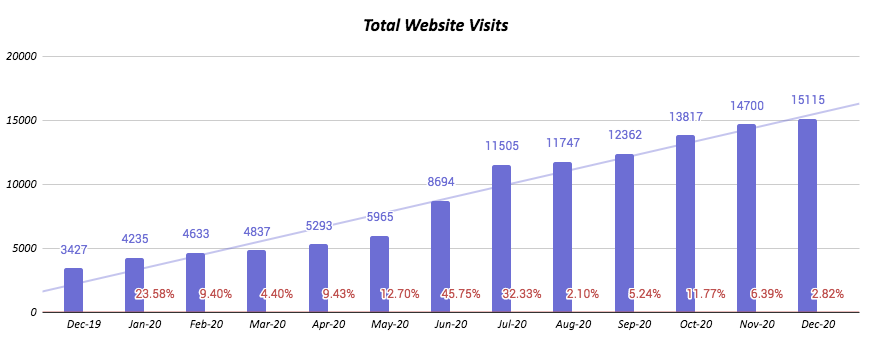
Website Visits by Source
People come to your site via numerous pathways. Use this info to gain insight on where to focus your effort moving forward.
- Is one source performing better than another?
- Where can you iterate?
- Where can you improve?
Look at traffic from each source:
- Direct traffic
- Email marketing (automations and campaigns)
- Organic search
- Paid search
- Paid traffic (ie: Facebooks ads)
- Referrals
- Other
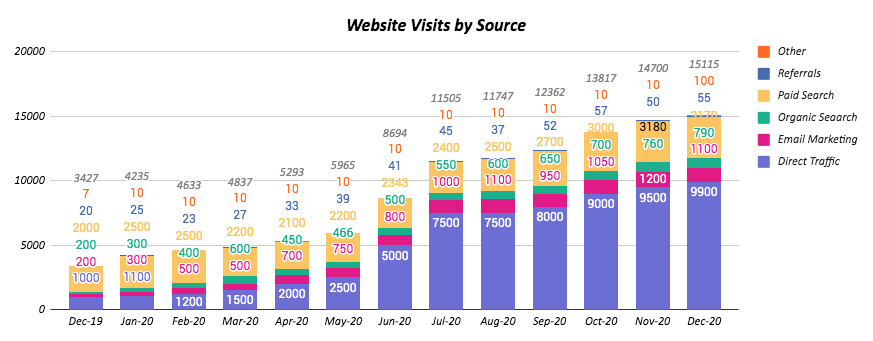
Organic search traffic
93% of online experiences begin with a search engine.
Search Engine Journal
How are you doing in search?
- When you do come up, do your listings stand out (titles and descriptions)?
- Are you appearing in any of Google’s special highlighted places?
- Do you rank for any relevant and desired search terms?
- Do you have optimized titles, descriptions, image alt tags and interpage linking on your site?
- Do you have a good amount of backlinks?
Is SEO something you need or want to focus on in the next 90 days?
Leads
Lead measurement is one of marketing’s strongest ROI indicators. Leads nurture into paying customers, and it is important to measure how much new interest you are generating for your products and services.
Total Leads Generated
How many leads are you generating each month? How much is this number growing over time?
When you factor in your conversion rates for traffic-to-lead and lead-to-customer, this can become a predictor of future revenue. XXXX Traffic > xxx Leads = xx Customers worth an average of $xxxx per sale (and $xxxxx lifetime value). See next tab in the Marketing Metrics Worksheets.
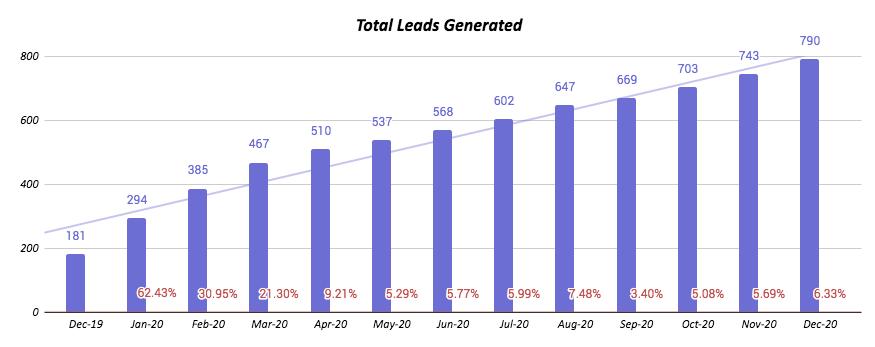
Leads Generated by Source
Use this metric to help identify your most effective lead-producing channels. Are you generating more leads via social or email? If you know this, you can improve your marketing campaigns and focus on your most valuable sources… or perhaps try to improve on the others.
Look at leads generated from each source:
- Direct traffic
- Email marketing (automations and campaigns)
- Organic search
- Paid search
- Paid traffic (ie: Facebooks ads)
- Referrals
- Other
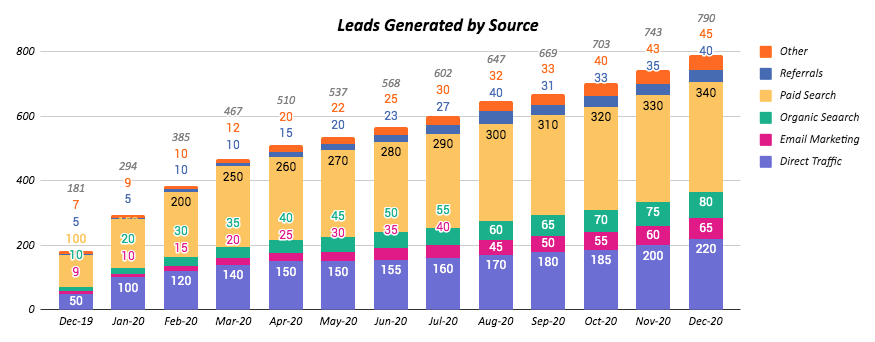
Customers
Total Customers
How many customers were acquired by your marketing efforts?
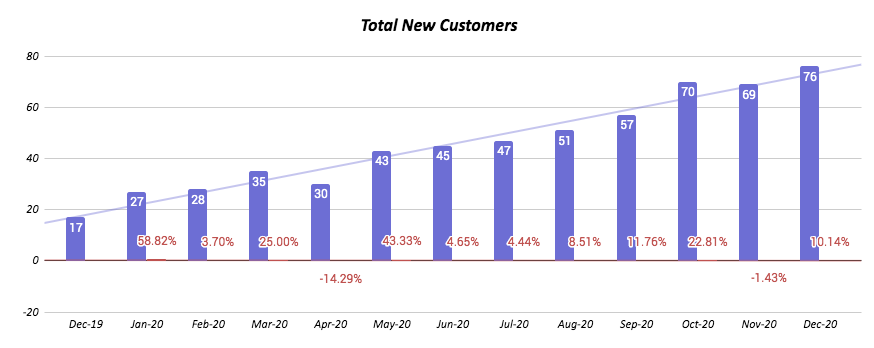
Customers by Source
Track which marketing campaigns and sources are yielding the most new customer acquisition. Double down on what is working well. Focus on others for improvement.
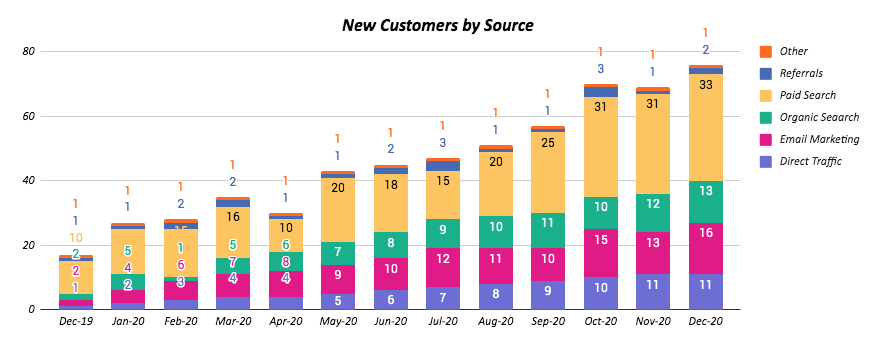
Other things to look at:
- One-time purchasers
- Repeat customers
- Recurring revenue opportunities
- Reviews/referrals
Customers who purchased once
It costs less to get more sales from existing customers than it does to acquire a new customer. Think about ways to stimulate repeat purchases. Also what can you do to stimulate Referrals and Reviews from them?
Customers who have purchased more than once
These are your VIPs. Consider what types of related products and services you can offer these customers to provide more value and enhance your relationship with them. Also encourage them to refer others to you and/or to write a review.
Non purchasers
These are people who visited your site, you have captured their email, maybe even had a sales conversation at some point… but they have not purchased. They might also be former customers who have not come back in awhile.
How can you engage them and nurture them to a sale? Think of where they are in their journey and what you would say to them next if you were to you run into them. Think in terms of a real world conversation.
You’d probably ask how they are, what’s going on in their world? How’s business? This is a great place to start. Your email automation tool is probably tracking their interests and what pages they visited. Use what you know about them to re-engage and nurture these relationships.
Conversion Rates
Conversion rates measure the number of people moving from one marketing stage to the next. An increase in conversion rates implies an improvement in the quality of content, or traffic or other relevant factors (like landing page design).
Visit-to-Lead Conversion Rate
How many of your website visits are becoming new leads for sales? One way to improve this metric is to better guide your visitors to your landing pages with calls-to-action to opt-in for something.
Lead-to-Customer Conversion Rate
This metric helps you understand if you are generating quality, sales-ready leads or not. If you improve this metric, you can increase customer acquisition without needing additional leads. Also look at what you are doing to ask for the sale. Don’t be afraid to make the ask.
Visit-to-Customer Conversion Rate
This is the big picture view as to how is your funnel functioning as a whole. If you know your visit-to-conversion rate, you can calculate how much traffic you need to generate to achieve a certain number of new customers.
Increasing your conversion rate by even 1% can have a significant impact on your revenue. Use the last tab in the Marketing Metrics Google Sheet — Marketing ROI Calculator – to play with the numbers and see the financial impact created by increasing your conversion rate by 1%, traffic by 30%, or BOTH.
Cost per lead, cost per sale, ROI per dollar invested
These three numbers make up the magic formula for marketing success.
We use a custom spreadsheet for Content Creators Planner that we created to track the revenue and costs per channel to determine profitability. (i.e. sales generated from Facebook ads, less ad spend, agency fees, shipping and COGs.)
Create a plan for tracking going forward and create a schedule for reviewing those numbers to check them against projections. Review at least once a quarter, make adjustments and keep going. (We review ours monthly)
Email Marketing & Marketing Automation
Email marketing has the highest ROI of all marketing channels with an average return of $38 for every $1 spent. It is also the most personal. We all get too much email, I know… However, it works.
Review the current state of your email marketing practices for things such as:
- List growth month-over-month (12% is a good target, factoring for unsubscribes as well)
- Revenue Generated — tools like ActiveCampaign (and even Mailchimp) will show you revenue generated from broadcast email campaigns and automations.
- Open rate and click rate (engagement).
- Consider that even if someone stays on your list but doesn’t open most of your emails — you are still showing up on their radar with each email sent. They do see your name right there in their inbox. When the time is right for them to refer or to reach out, or to click and even to buy, they are more likely to think of you.
- Do you email on a consistent and predictable schedule?
- Are your emails personalized? (beyond Hi Fname…)
- Do you use conditional content based on pages visited, or other interest or product tags?
- Do you have specific content relevant to their stage of their customer journey?
- Are you providing value in your emails? Are you addressing their needs?
- Do you ask for the sale?
- Watch your rate of unsubscribes. If it seems high, it could be your audience is not interested in what you are sharing, or your audience is not targeted enough for what you offer.
- Are your lists segmented in ways that are useful to you? (buyers by product, influencers, interest tagging, geography, etc.)
- Do you have email content for each stage of your funnel?
Website
I could write an entire book about website best practices, but for our purposes here, we’ll just focus on some basics.
Review your website and consider:
- Is your content current?
- Does it look current (visually)?
- Is it clear what you do, who you do it for and why they should care?
- Is it easy to buy from you?
- Is there a clear path what they should do next?
- Is it easy to contact you?
- Have you included social proof and other authority signals?
- Do you have landing pages for your lead magnets and core products/services to which you drive traffic?
- Does your site perform well for both mobile and desktop?
- Is your site speedy enough?
Something I’d like to point out here is that often, we get tired of our own things… saying the same things, looking at the same things, etc. But that doesn’t mean it is time for a refresh. Most people need to see and hear things 7-11+ times before it really sticks. Many are seeing/reading/hearing you and your stuff for the first time. So just because you are tired of it, does not mean it is time for a refresh. Put your time and effort into the most essential things.
Content Audit
Quality content is one of our greatest assets as a marketer. Most of us focus our energy on creating new content, which is a good thing, but we must also review what we already have from time to time.

Review content from last 6 months.
- Do you have existing content that needs to be updated?
- Do you have content that can be repurposed?
- Read blog post and publish as audio content/podcast.
- Read snippets from a post or copy snippet from audio and use as micro content to drive traffic and engagement from social media.
- Create a video version of a post and publish to youtube.
- Take FAQs from sent emails and use in email nurture or publish as a blog post.
- Do you have content that should be unpublished?
- Do you have gaps — content that needs to be created?
- Do you have quality content at each stage of your customer journey?
- Are you continuing to promote older/existing content?
Customer Experience
Seth Godin says we should be remarkable — worth remarking about, like a purple cow. Are you?
If you are not providing an exceptional experience from start to finish, you have work to do. We all do.
- Review your customer on-boarding practices. Do you have a documented process? Can it be improved/refreshed?
- What is delivery like? Do you have documented workflows and scheduled communications with clients throughout the engagement? Is it consistent? Can it be improved?
- Are clients/customers raving fans in the end?
- Customer off-boarding: What does this look like? Is it documented and consistent?
- Do clients/customers refer others to you? Do they provide testimonials and reviews?
- Have you surveyed your customers to see where you can do better? And if they have needs you might be unaware of?
- What about customer support?
- How do you handle it when things go wrong?
Social media
In order to review your social media in terms of your marketing, you need to consider your goals and then look at things like:
- Which channels you are on and why (is your audience there?)
- Should you add or abandon any channels?
- How much time are you spending on these channels? Is it fruitful?
- Is your audience (reach) growing?
- Do you have good engagement?
- Do you get a decent amount of traffic from social to your website content?
- Do you convert followers to leads? Do these leads convert to customers?
- Do you convert any social traffic directly to sales?
There is some value to vanity metrics like number of followers in that it is a form of social proof. But if there are no engagement and no leads being generated, does it really matter? There is also value in positioning yourself as a trusted authority by being visible and active.
That being said, all marketing activities should be focused around your goals and your sales funnel.
Think strategically here so that you can use social media for the Know-Like-Trust-Try stages of your funnel. You can also engage existing customers and get reviews and referrals here as well.
And of course, you can use paid social traffic to lead magnets, content and even directly to product sales pages.
Offline Activities
Not all marketing happens online. Mind blowing, I know!
In person networking events, live speaking engagements, live workshops, seminars and conferences… are all solid marketing activities that should be considered.
We won’t be under the threat of COVID19 forever. Consider laying the foundation now for when this virus is contained, so that you are positioned at the starting blocks to bolt out in front when the time comes.
- Research speaking opportunities to groups and conferences.
- Consider partnering with a colleague to offer a seminar or workshop (for greater reach, wider pool).
- Identify networking events you might like to check out.
For now, please be safe and practice social distancing. The world needs you.
Audit your products and promotions mix
- Has there been any shift in the products or type of products being purchased?
- Do you have any insights as to why?
- How is this impacting your revenue and profitability?
- Are there products you should promote more heavily?
- Are there any to phase out (possibly at a discount?)
- Do you have any promotions you should extend?
- Any to add? (consider upcoming holidays and other important dates)
Assess your business enviromment
Yes, 2020 has been a real tosser so far! How is the current economic environment affecting your business and what can you do about it?
Think lean.
- Where can you cut back on costs?
- Where can you stimulate sales for easy wins? And longterm?
- How can you be most efficient with your time and resources (financial and human) to get the highest returns?
- Which marketing activities have highest ROI for you and your bottom line?
Last but not least… Review your review process (Dept. of Redundancy Dept.)
Now it’s time to review your review.
With everything you have just reviewed and aggregated, plus all the notes and ideas you recorded along the way, it’s time to take a break and reward yourself for doing all this!

Next, it’s time to take action. With the insights have you gained, define your goals for 3rd and 4th quarters and begin crafting your plan to achieve them.
Be realistic. Play to your strengths, hire for your gaps…the key things are to 1) have a strategic plan, 2) schedule tasks and 3) take consistent imperfect action.
- What are your goals?
- What tactics will you use to get there?
- What schedule can you sustain? Will you need help?
- What KPIs will you monitor and and how and when will you know if you succeeded?
You got this!
Please comment below. I would really love to hear from you about how this process worked for you and if you have any suggestions for improving it. I want this to be a valuable tool to help others like you get the most from their marketing efforts.
Tools and resources we use, love and recommend
Content Creation
Jarvis.ai – Let Jarvis write proven, high converting copy for your ads, emails, websites, product descriptions, blog posts and more! It is truly amazing.
Email Marketing & Automation
ActiveCampaign
Social Post Scheduling
Co-Schedule – we also love their headline analyzer and requeue feature
SEO Tools
Ubersuggest (free and easy)
Moz Link Explorer
SEMrush
ahrefs
Blog post traffic spreadsheet (free, courtesy of Buffer)
This sheet shows you which blog posts are getting the most traffic, allowing you to make sure you know which content is working, what isn’t and your best performing topics.
Sheets for Marketers (free, motherload of Google sheets for marketers)
Download Our Free Marketing Metrics Worksheets
Use these to record, analyze and visualize your data to get a clear view of what is happening in your marketing.


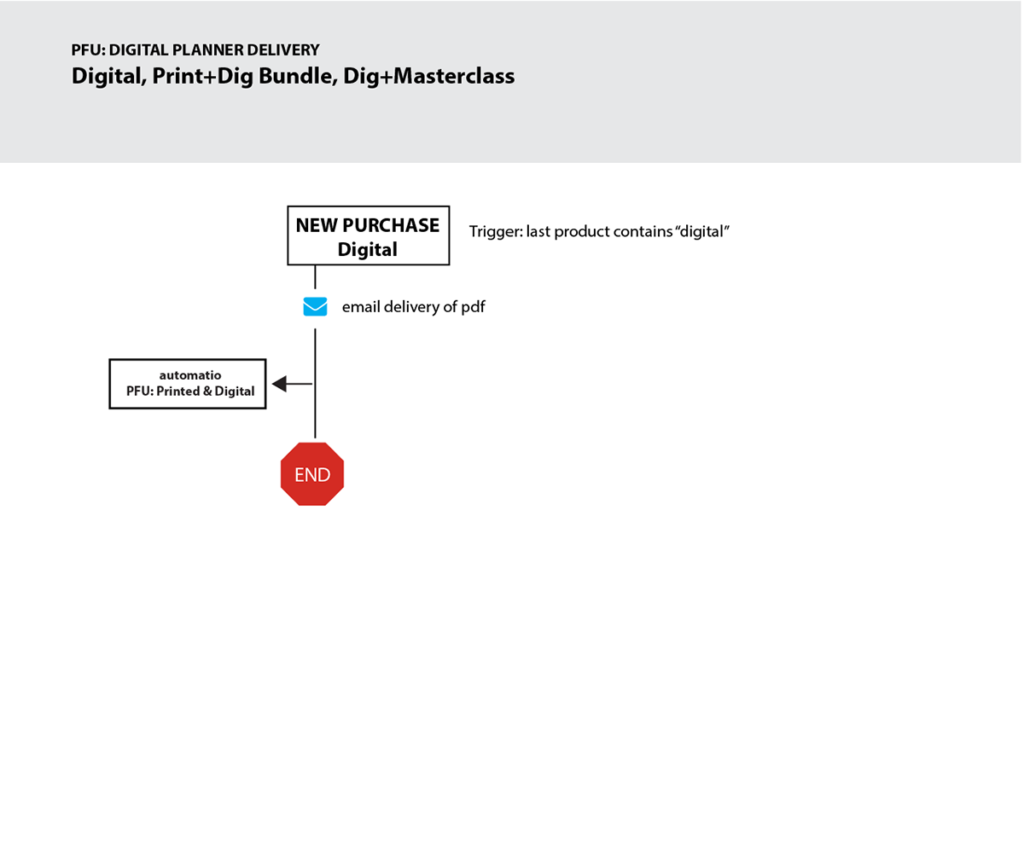

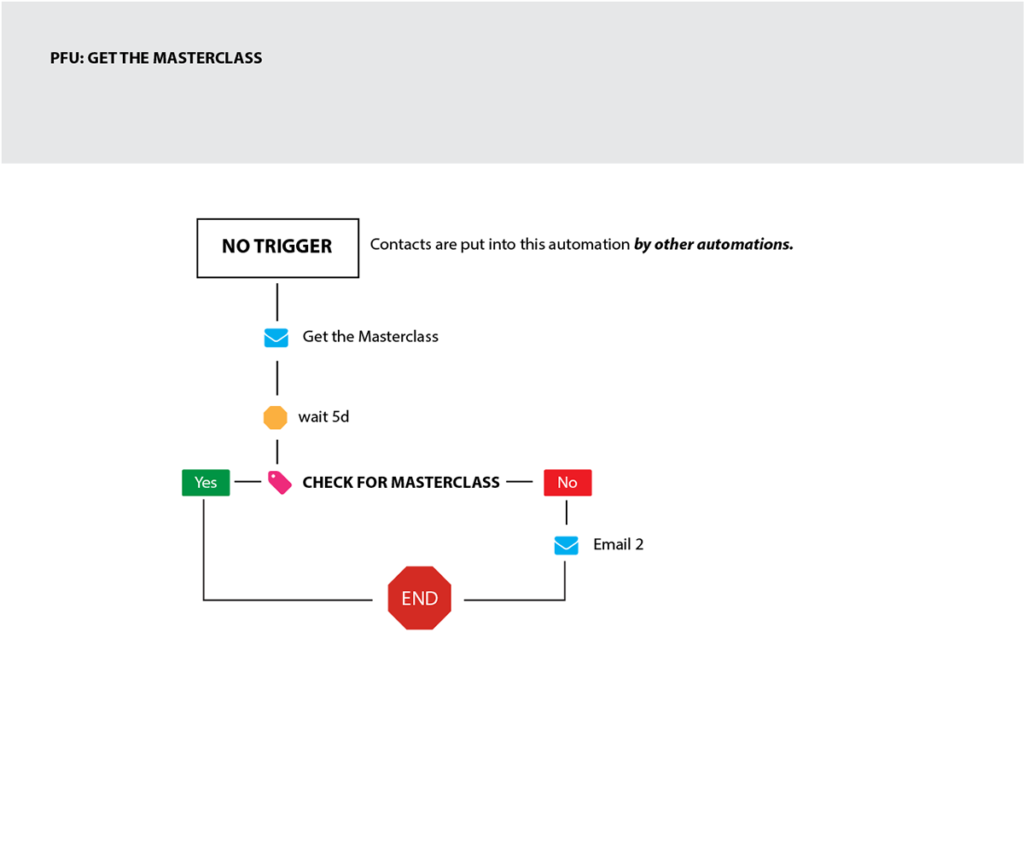
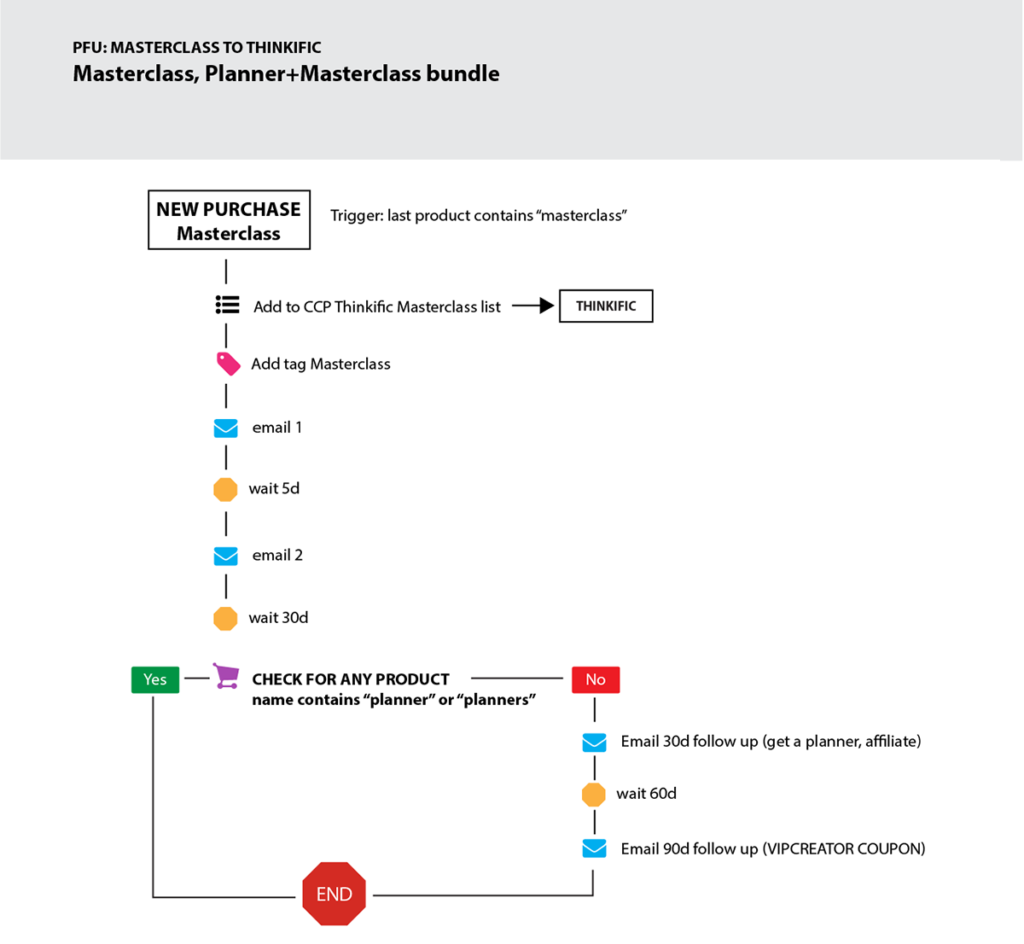

WOW! Best blog EV-ER! A social media marketing checkup in English. If you take care of your personal health checkupS why wouldn’t you do it for your business. I love the step by step with references and the simplicity of the process. Each link is like getting a lollipop from the doctor. I’m so inspired I’ve scheduled a day to take care of this. Thanks ladies for an awesome job. And the hard work that went into putting this post together.
Thanks, Dawn! I literally laughed out loud at “Each link is like getting a lollipop from the doctor.” LOL So glad to hear this feedback and to know that this post was worth the massive undertaking that it was 🙂 Please reach out to us if you have any questions.
WOW! Best blog EV-ER! A social media marketing checkup in English. If you take care of your personal health checkupS why wouldn’t you do it for your business. I love the step by step with references and the simplicity of the process. Each link is like getting a lollipop from the doctor. I’m so inspired I’ve scheduled a day to take care of this.
Absolutely solid content! Thank you, Jodi!
Unfortunately, there are courses out there that teach you for hundreds of $$ what you’ve just jotted down above for us all!
Thanks, Babett! I hope it helps you and others get more from their marketing efforts. 🙂